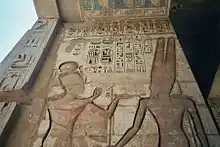Incense burner: arm (hieroglyph)
The ancient Egyptian Incense burner: arm is a horizontal hieroglyph representing various types of horizontal tools used to offer, and burn incense. In tomb scenes it is often shown with an attached small box, or cup region, for holding incense, located on the upper surface; the offering individual is sometimes holding a grain-pellet of incense, with lines of incense, or connected grains-in-a-line equal to wafting smoke.
| Incense censer (horizontal, as ~arm) in hieroglyphs |
|---|
Incense was used from the beginning dynasties of Ancient Egypt.
The horizontal incense burner is a determinative in Egyptian language k3p, for "incense, to make smoke".[1] The phonetic value of the hieroglyph is kp.[2]

Egyptian Third Intermediate Period bronze incense burner
Incense burner: pot
| Common Incense Burner: Pot in hieroglyphs |
|---|
The other common type of hieroglyph for the burning of incense, is a small pot, with a flame, flickering from the top surface, "Incense burner: pot with smoke". The censer pot has one major usage in front of the feet of the "Soul" bird, the Ibis,
but is also replaced in rare instances with a meteor hieroglyph,[3]
, (not Gardiner listed).


 Censer arm artefact
Censer arm artefact Incense-smoke with "grains"-of-incense
Incense-smoke with "grains"-of-incense
See also
| Wikimedia Commons has media related to Incense burner: arm. |
| Wikimedia Commons has media related to Incense burner: pot. |
| Wikimedia Commons has media related to Incense. |
References
- Betrò, Hieroglyphics: The Writings of Ancient Egypt, "Incense burner", p. 215.
- Betrò, p. 215.
- Meteor hieroglyph, (Wikimedia Commons)
- Betrò, Maria Carmela. Hieroglyphics: The Writings of Ancient Egypt, c. 1995, 1996-(English), Abbeville Press Publishers, New York, London, Paris (hardcover, ISBN 0-7892-0232-8)
This article is issued from Wikipedia. The text is licensed under Creative Commons - Attribution - Sharealike. Additional terms may apply for the media files.